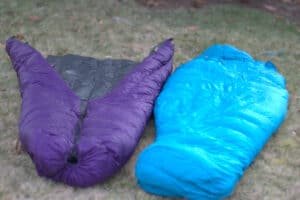Backpack with Power: Best Solar Chargers of 2023

Are you an outdoor enthusiast planning your next backpacking trip and worried about running out of battery on your electronic devices? Look no further! We’ve compiled a list of the best solar chargers for backpacking, so you can stay connected with nature and capture all those stunning moments without worrying about a dead battery. Our expertly curated selection of the best portable solar chargers includes a variety of options to fit your budget and charging needs, ensuring that you’ll have reliable power throughout your adventure. So, whether you’re a seasoned backpacker or a first-time camper, reading this list will ensure you have the best solar charger for backpacking in your pack.
What is the Best Solar Charger for Backpacking?
- Best Overall Solar Charger: BigBlue 3 28w
- Best High Power Solar Charger: FlexSolar 40w
- Best Ultralight Solar Charger: ECEEN 13w
- Best Durable Solar Charger: Ryno Tuff 21w
- Best Universal Solar Charger: MARBERO 30W
Best Overall Solar Charger
1. BigBlue 3 28w
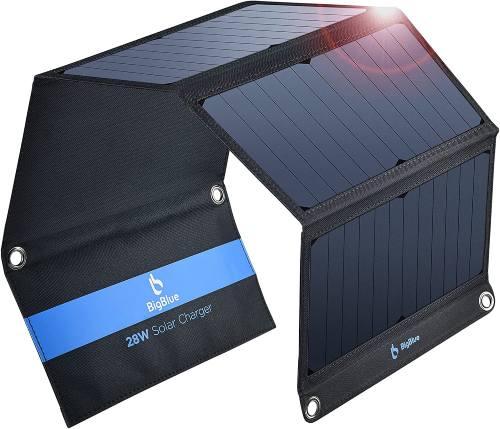
Power: 28 watts
Weight: 1.25lbs ( 20.05oz )
Dimensions: 11.6 × 6.3 × 1.3in folded
Advantages: The big blue solar charger is a lightweight and portable option for charging devices on the go, and it has three USB ports for charging multiple devices simultaneously.
Disadvantages: With a lower wattage compared to some of the other options on this list, it may take longer to charge larger devices like laptops.
The BigBlue3 Solar 28W is amongst the best solar chargers on the market that is perfect for outdoor enthusiasts and travelers. It’s a well-designed and efficient charging solution that delivers fast and reliable charging to multiple devices simultaneously. The three solar panels are foldable with high efficiency and can generate up to 28 watts of power, which is impressive and makes it one of the most powerful solar chargers on the market.
The intelligent chip of this charger can detect the device and adjust the charging speed accordingly. This feature is especially helpful in ensuring that your devices charge quickly and safely without damaging the battery. Additionally, the built-in ammeter provides real-time information about the charging process, making it easier to monitor and adjust as necessary.
The BigBlue3 Solar 28W is built to withstand harsh outdoor conditions, and its weather-resistant design makes it an ideal charging solution for outdoor activities like camping, hiking, and backpacking. Its lightweight and compact design makes it easy to carry and store, and the included hook makes it simple to attach to your backpack or tent.
Best High Power Solar Charger
2. FlexSolar 40w
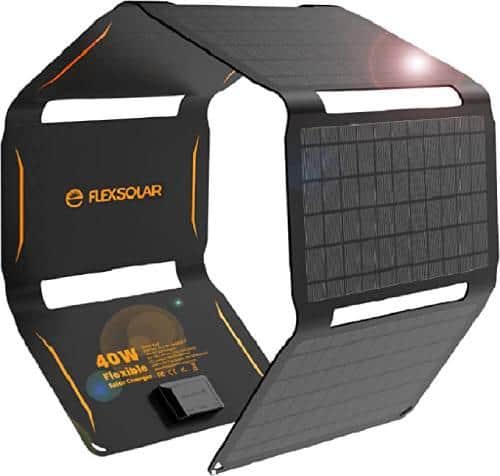
Power: 40 watts
Weight: 2.87lbs ( 45.92oz)
Dimensions: 11.1 x 8.0 x 1.8in folded
Advantages: The FlexSolar 40W is a high-wattage option that can charge larger devices quickly, and it comes with four carabiners for easy attachment to backpacks or other gear.
Disadvantages: It is a bit heavier and bulkier than some of the other options on this list, so it may not be as convenient for on-the-go charging.
The FlexSolar 40W solar charger is an excellent high-power charging solution for anyone who spends a lot of time outdoors. With its compact and foldable solar panels, it’s easy to carry and store, making it a great option for a backpacking solar charger. It is also one of the best camping solar chargers.
One of the standout features of this charger is its high power output. The four solar panels can generate up to 40 watts of power, which is enough to charge multiple devices simultaneously. The intelligent chip technology ensures that your devices charge quickly and safely, while the built-in ammeter provides real-time information about the charging process.
The FlexSolar 40W is also designed to be durable and weather-resistant, making it an ideal charging solution for use in outdoor conditions. The waterproof and dustproof design protects the charger from rain, dust, and other elements. Additionally, the charger’s rugged construction ensures that it can withstand bumps and falls.
Overall, the FlexSolar 40W is an excellent high-power solar charger that offers fast and efficient charging while being portable and durable. It’s a great option for anyone who needs a reliable charging solution that can handle the demands of outdoor life.
Best Ultralight Solar Charger
3. ECEEN 13w
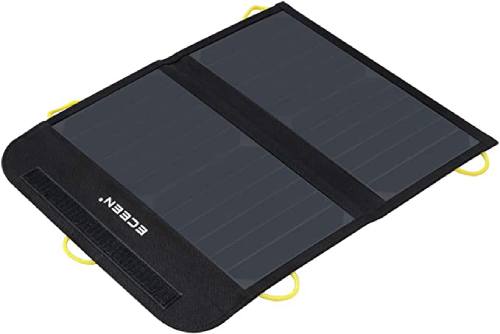
Power: 13 watts
Weight: 1.08 lbs
Dimensions: 11.1 X 6.3 x 1.06in folded
Advantages: The Eceen 13W is an affordable and compact option that can easily fit into a backpack or purse, and it includes a built-in battery for storing power.
Disadvantages: The lower wattage may make it less effective for charging larger devices or multiple devices at once.
The ECEEN 13W is an ultralight and portable solar panel that is perfect for travelers and hikers who need a lightweight foldable solar panel and compact charging solution. It’s a small but powerful charger that can deliver efficient charging to your devices using the sun’s energy.
One of the standout features of this charger is its ultralight design, which makes it easy to carry and store. It’s only 0.59lb in weight, and its compact size makes it easy to fit in a backpack or pocket. Despite its small size, the charger’s monocrystalline solar panels can generate up to 13 watts of power, which is enough to charge most small electronic devices.
The ECEEN 13W also has smart charging technology that can detect the device you’re charging and adjust the charging speed accordingly, ensuring that your device charges quickly and safely. Additionally, the charger has a built-in pocket that can hold your device while charging, keeping it safe and secure while you’re on the go.
Overall, the ECEEN 13W is an excellent ultralight and portable solar charger that delivers efficient and reliable charging while being easy to carry and store. It’s a great option for anyone who needs a lightweight and compact charging solution that can keep their devices powered up while on the move.
Best Durable Solar Charger
4. Ryno Tuff 21w
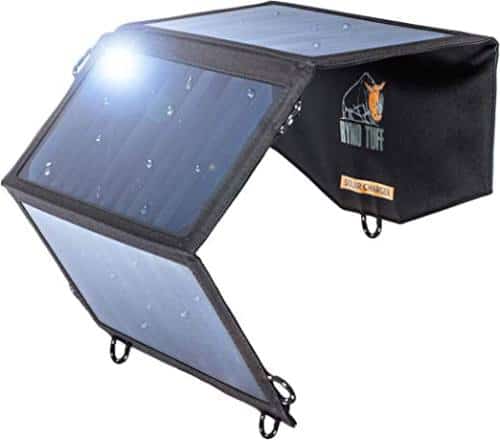
Power: 21 watts
Weight: 1.06 lbs
Dimensions: 11.8 x 5.9 x 1.5in folded
Advantages: The Ryno Tuff 21W is a durable and waterproof option that is great for outdoor use, and it includes three USB ports for charging multiple devices simultaneously.
Disadvantages: It may be a bit heavy and bulky for backpacking or hiking, and the wattage may not be sufficient for charging larger devices like laptops.
The Ryno Tuff 21W is a durable and sturdy solar charger that is built to withstand harsh outdoor conditions. It’s a high-quality charging solution that can deliver efficient and reliable charging to your devices using the sun’s energy.
One of the standout features of this charger is its rugged and durable construction. The charger is designed to be waterproof, dustproof, and shock-resistant, making it an ideal charging solution for use in outdoor conditions. Additionally, the charger’s foldable and compact design makes it easy to carry and store, making it an excellent option for hikers, campers, and travelers.
The Ryno Tuff 21W also has smart charging technology that can detect the device you’re charging and adjust the charging speed accordingly, ensuring that your device charges quickly and safely. Additionally, the charger’s built-in ammeter provides real-time information about the charging process, making it easier to monitor and adjust as necessary.
Overall, the Ryno Tuff 21W is an excellent durable, and sturdy solar charger that delivers efficient and reliable charging while being built to withstand harsh outdoor conditions. It’s a great option for anyone who needs a high-quality charging solution that can handle the demands of outdoor life.
Best Universal Solar Charger
5. MARBERO 30w
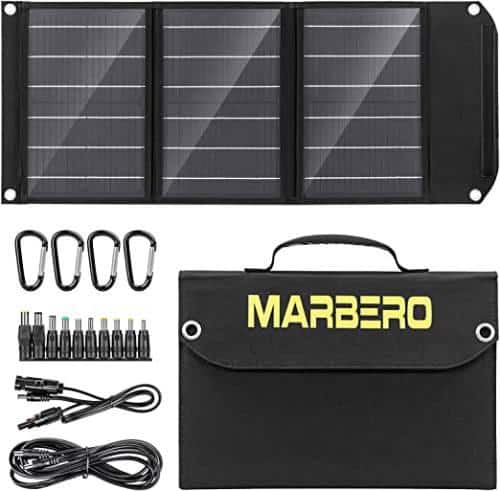
Power: 30 watts
Weight: 2.65 lbs
Dimensions: 13.7 x 7.6 x 1.3 inches folded
Advantages: The Marbero 30W is a high-wattage option that can quickly charge larger devices, and it includes four carabiners for easy attachment to backpacks or other gear.
Disadvantages: It may be a bit heavy and bulky for on-the-go charging, and it is one of the more expensive options on this list.
The MARBERO 30W solar charger is a high-quality and versatile charging solution that stands out for its universal compatibility with a wide range of devices. With its four solar panels generating up to 30 watts of power, the charger can deliver efficient charging to smartphones, tablets, and other USB-powered devices.
One of the key features of the MARBERO 30W is its universal compatibility, which makes it an excellent choice for travelers or anyone who needs to charge multiple devices on the go. The charger comes with a variety of connector cables and can be used with virtually any device that has a USB port, including iPhones, Samsung Galaxy phones, iPads, and more.
In addition to its universal compatibility, the MARBERO 30W is also designed to be durable and weather-resistant, making it an ideal charging solution for use in outdoor conditions. The waterproof and dustproof design protects the charger from rain, dust, and other elements, while the rugged construction ensures that it can withstand bumps and falls.
Overall, the MARBERO 30W solar charger is a highly versatile and reliable charging solution that is well-suited for outdoor enthusiasts and frequent travelers. Its universal compatibility and durable design make it a great choice for anyone who needs to charge multiple devices while on the go.
Solar Power Charger Buying Advice
How to Use
Solar chargers for backpacking are an excellent way to keep your electronic devices charged while on the go. These chargers can be used for charging electronic devices directly or in conjunction with a battery or a solar generator. Their main purpose is power generation.
When charging devices directly, the solar charger is connected to the device using a USB cable. As the solar panels absorb sunlight, they convert it into electrical energy, which is then used to charge the device’s battery. This method is ideal for those who want to travel light and don’t want to carry any additional equipment.
However, charging devices directly may not be the most efficient way to use a solar charger. The charging speed will depend on the amount of sunlight available, and in some cases, the charger may not generate enough power to fully charge the device’s battery.
Using a power bank separately, or a solar generator in conjunction with the solar charger can help overcome these limitations. A battery or a solar generator, like the Jackery solar generator, acts as a storage device for the electrical energy generated by the solar panels. The solar charger is connected to the battery or solar generator, and the device is then charged using the stored energy.
This method allows for more efficient charging, as the battery or solar generator can store energy when the sun is shining and release it when needed, providing a steady and reliable power source for the device. Additionally, a battery or solar generator can also be used to charge devices overnight or during periods of low sunlight.
In conclusion, when selecting a solar charger for backpacking, it’s important to consider how it will be used, whether it will be used to charge devices directly or in conjunction with a battery or solar generator. Understanding the different charging options available can help you choose the best solar charger for your backpacking needs.
Size and Weight
When it comes to buying a solar charger for backpacking, size, and weight are crucial considerations. The ideal solar charger should have a lightweight solar panel and be compact, allowing you to easily carry it with you on the trail without adding too much weight to your pack.
Look for a solar charger that is designed specifically for backpacking or outdoor use, as these are typically smaller and lighter than larger, more powerful solar chargers designed for home use. A good rule of thumb is to look for a solar charger that weighs no more than a pound and can easily fit in your backpack without taking up too much space.
Another factor to consider is the size and number of solar panels on the charger. More solar panels generally mean more power output, but they also mean more weight and bulk. Consider your charging needs and choose a solar charger with the appropriate number of panels to meet those needs without adding unnecessary weight.
If you also do a lot of car camping, you might want to consider a middle-of-the-road size panel that can fit your needs for both activities. They can also integrate with your portable power station, or be added to other portable solar panels.
Ultimately, the size and weight of the solar charger will depend on your specific backpacking needs and preferences. Consider the length of your trip, the amount of charging you’ll need to do, and the weight of your pack overall when choosing a solar charger for backpacking.

Solar Panel Type
When selecting a solar charger for backpacking, it’s important to consider the solar panel type of the charger. There are two main types of solar panels used in backpacking solar chargers: monocrystalline and polycrystalline. Check out the difference between monocrystalline and polycrystalline.
Monocrystalline solar cells are more efficient and durable than polycrystalline panels, which means they can generate more power in less space and are better suited for harsh outdoor environments. However, they are also more expensive than polycrystalline panels.
Polycrystalline solar panels are less efficient than monocrystalline panels, which means they require more space to generate the same amount of power. However, they are also less expensive than monocrystalline panels and are a good choice for backpackers on a budget.
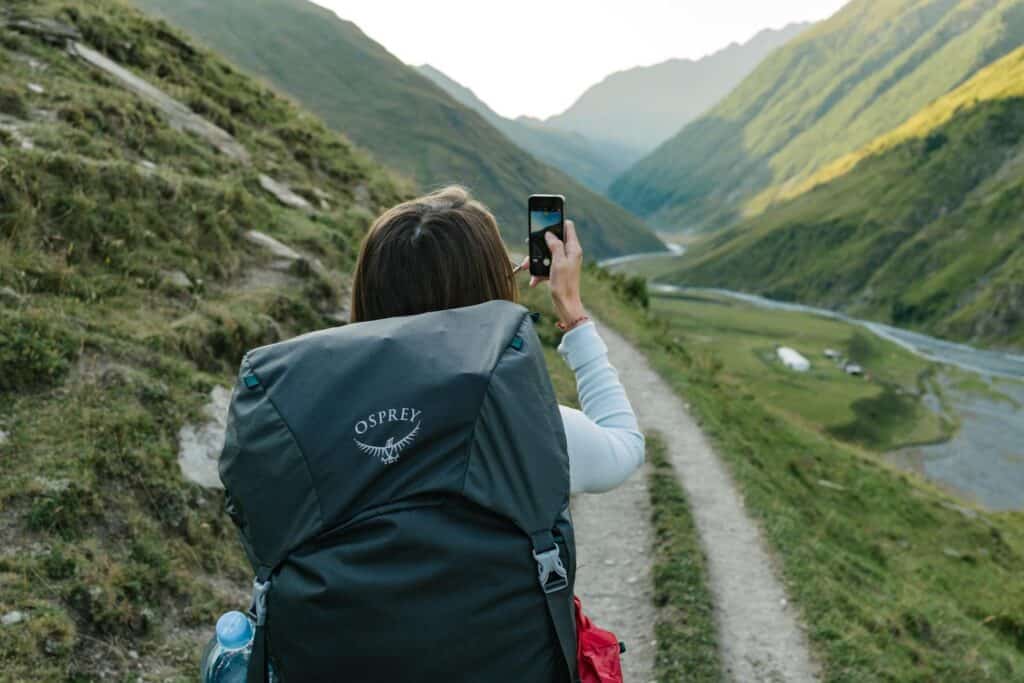
Device Charging Options
When selecting a solar charger for backpacking, it’s important to consider the device charging options that the charger offers. Look for a charger that includes multiple charging ports and different types of connectors, so you can charge a variety of devices, including smartphones, tablets, cameras, and GPS devices.
Ideally, you’ll want a charger that includes both USB and DC output ports. USB ports are great for charging smartphones and other small devices, while DC ports are better suited for larger devices like tablets and laptops. Make sure that the charger’s DC output voltage matches the voltage requirements of your devices, as using the wrong voltage can damage your electronics.
It’s also important to consider the charging speed of the charger. Look for a charger that supports fast charging technologies like Quick Charge or Power Delivery, which can significantly reduce the amount of time it takes to charge your devices. However, keep in mind that faster charging speeds may require more power from the solar panels, which can impact the size and weight of the charger.
Finally, consider any additional features that the charger may offer, such as built-in LED lights, battery level indicators, or integrated power banks. These features can make the charger more versatile and convenient to use during your backpacking trips. However, keep in mind that additional features may add to the size and weight of the charger, so consider what features are essential for your needs.
Power Output
When choosing a solar charger for backpacking, the power output of the charger is an important factor to consider. A charger’s power output determines how quickly it can charge your devices and how many devices it can charge at once.
For backpacking, you’ll want a solar charger that has enough power output to charge your essential devices, such as your phone, camera, and GPS, but not so much power that it’s heavy and bulky. Look for a charger with a power output between 5W and 15W, which should be sufficient to charge most devices you’ll be using on the trail.
Another important consideration is the efficiency of the charger. A more efficient solar charger will be able to convert more of the sun’s energy into usable power for your devices, which means faster charging times and less time spent in direct sunlight. Look for a charger with a high conversion efficiency, such as 20% or higher, to ensure you’re getting the most out of your solar charger.
Lastly, keep in mind that the power output of a solar charger can vary depending on weather conditions and the angle and position of the panels about the sun. Be sure to position your solar charger in direct sunlight and adjust its position as needed throughout the day to maximize its power output.

Durability
Durability is a key factor to consider when buying a solar charger for backpacking. You’ll want a charger that can withstand the wear and tear of being carried in a backpack, exposed to the elements, and potentially dropped or bumped during your hike.
When looking for a durable solar charger, consider the materials used in its construction. Look for a charger with a sturdy, impact-resistant casing that can protect delicate solar panels from damage. Waterproof and dustproof ratings can also be helpful, as they can protect the charger from water damage and dust infiltration during your hike.
Another factor to consider is the build quality of the charger. Look for a charger with solid craftsmanship and attention to detail, such as reinforced seams and high-quality connectors. These features can help ensure that the charger will hold up over time and continue to function properly even after extended use.
Finally, be sure to read reviews and feedback from other backpackers who have used the charger you’re considering. Look for reviews that specifically mention the durability and longevity of the charger, as this can be a good indicator of how well it will hold up during your backpacking adventures.
Conclusion
After looking at all the features and benefits of a solar charger, it’s clear why it is an essential piece of equipment for any avid backpacker. Not only does a solar charger provide you with power no matter where your adventure takes you, but it can also help conserve scarce resources by using renewable energy from the sun. With faster charge times, increased safety measures, and even water resistance, the latest solar chargers are perfect for backpacking trips both long and short. Investing in one of these life-saving pieces of technology will give you peace of mind, knowing that you will always have access to reliable power no matter where your adventures take you.

